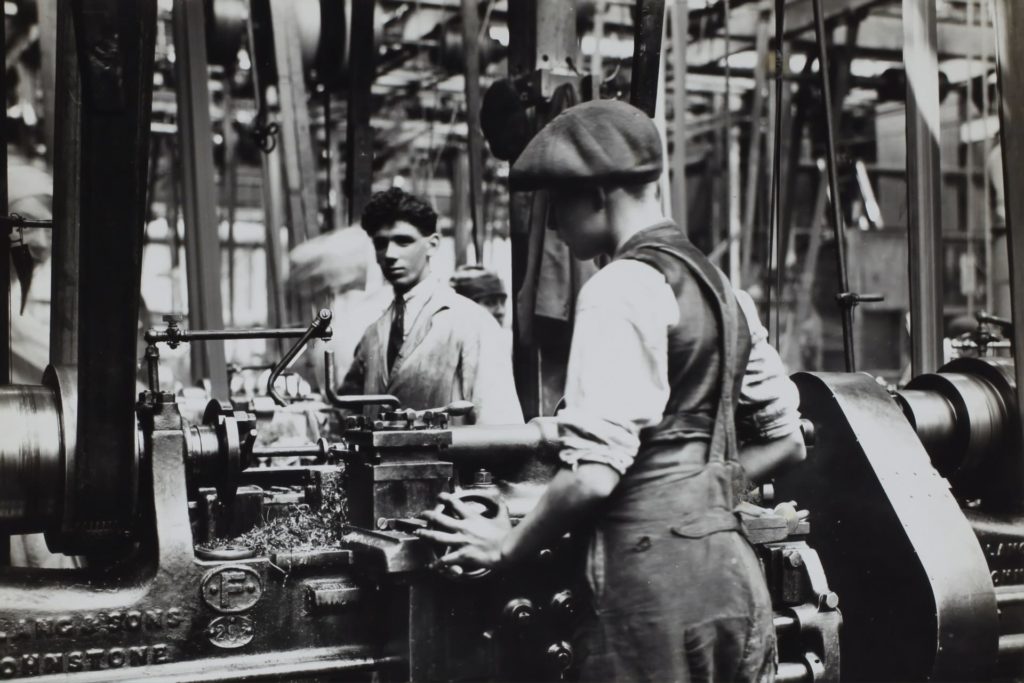Circular Perspectives for Linear Mindsets
How did linear thinking succeed in dominating our mental infrastructure? What can be done to change the linear mind-set of corporate and political leaders, and what should consumers do if they want to move away from a linear culture, linear products and a linear lifestyle?
REVOLVE Circular spoke with four innovative thinkers from India, Switzerland, Uganda and the USA to hear their circular views. Here is the interview with Walter R. Stahel, a Swiss architect and author of the “performance economy”; he has been influential in developing the field of sustainability, by advocating ‘service-life extension of goods – reuse, repair, remanufacture, upgrade technologically’ philosophies as they apply to industrialized economies.
Please allow us to start with a big question, or rather two: What is wrong with the linear economy? Since when?
The linear industrial economy started with the industrial revolution. Before that, a majority of people lived in a forced circular economy of scarcity and poverty.
Industrial mass production of almost anything enabled societies to gradually overcome scarcities of food, shelter and clothing. What is wrong with this? Manufacturers only optimize production flows up to the point of sale, where both ownership and liability of objects are transferred to the buyer, who later passes the responsibility for derelict objects and ‘waste’ to the municipality. What is wrong with this? Economically, manufacturers internalize profits and externalize the cost of risks during the use of objects to the buyer, and end-of-life costs to society—which means the taxpayer. This linear system from mines to the point-of-sale and on to landfills was tolerable until 1945 because ‘waste’ either had a value and was collected by ‘rag and bone men’ or was disposed of in Nature which slowly absorbed it.

After 1945, the scientific progress of the Anthropocene enabled humankind to manufacture objects made of synthetic materials, which were outside nature’s absorption capacity, both quantitatively and qualitatively. Derelict objects were still collected by municipalities and treated by recyclers or incinerated, but substantial numbers ended up in the environment (plastic in the oceans).
What is wrong with this? Framework conditions push recyclers to eliminate waste, even using illegal methods, instead of incentivizing them to preserve the value of objects and materials. And despite increasing environmental impairment, politics continue to support the linear economy.
Has linear thinking succeeded in dominating our mental infrastructure? If yes, then how?
Our mental infrastructure is determined by culture and religion, education, experience and incentives. In the East, the present life is often only one of many, birth leads to rebirth. In the West, the present life is unique and ends with death; most decisions are therefore taken to improve the wellbeing and welfare of future generations. Few family cultures and fortunes, typically invested in real estate and forestry, survive several generations; cultural heritage of national importance is mostly side-lined into museums and public institutions.
Politicians are acting in 4-year cycles until the next elections, a timeline incompatible with a vision. Corporate leaders have a short shelf-life of about 3 years, industrial companies of about 40 years. Keynes said that in the longer term we are all dead. Linear and short-termism go hand-in-hand.
Technologic progress is linear, exemplified by what I call the ‘bigger-better-faster-safer-greener’ syndrome in automobiles. Technical developments hitting a dead-end lead to depression and temporary paralysis: witness the Apollo program, started by John F. Kennedy with his declaration “The first man on the moon will be American” and terminated by the U.S. Senate after realizing that several kilograms of lunar stones, which the Astronauts had brought back, were the only concrete result.
Humankind’s linear thinking may prevent our mental infrastructure to distinguish between Nature’s circularity which remains steady – the water cycle, the tides, the seasons, fauna and flora – and anthropogenic interference like greenhouse gas emissions causing irreversible changes to the global climate. Humankind’s drive to permanently grow and improve based on science and short-term linear technical progress, witness plastic and fossil fuels, clashes with Nature’s development by evolution through selection. A different societal development following the Native Americans’ motto ‘In all your endeavors consider the impact on the next seven generations’ could bring our linear thinking more in line with Nature.
For change to happen, who needs to educate our political and corporate leaders, and on what? Or is it the consumers who need to change first?
For change to happen, society needs a vision of the future as well as safety barriers on the road to the future, such as the 7th Generation Principle. In the past, science often provided visions, religions the safety barriers. But today religion has often lost its clout, and the belief in scientists and science is dwindling or under heavy attack from fake news and conspiracy theories – vaccines against the Sars-CoV-2 virus are a prominent example.
For change to happen, it needs to be rooted in local culture. The objective of zero-waste motivates Japanese managers because waste is inefficiency; US managers, however, respond to money and can best be motivated by the objective of 100% yield, high profits, bonuses and efficiency.

For durable consumer goods, the owner-users of objects have always been in command; they determine the service-life of their belongings. For change to happen, education and motivation to turn consumers into users developing ‘teddy bear’ relationships with objects are a potential avenue.
Infrastructure and buildings are the biggest anthropogenic assets. They are owned by authorities and corporate entities, their decisions on procurement conditions and the quality of operation and maintenance determines the service-life of objects.
The quickest change-makers are cooperation and combination of corporates producing and selling performance, and public authorities buying objects as a service. Witness space transport: when NASA decided to decommission its space shuttles, it also changed its procurement policy from buying and operating hardware to procuring space transport services. This led to the creation of a number of start-ups, such as SpaceX and Odyssey Moon, which developed reusable rockets and transport capsules for competitiveness reasons.
A cooperation example is the TRUMPF Group and the Munich Re Group (Munich Re) entering into a strategic partnership for an innovative service offering of laser cutting machines. The jointly developed ‘pay-per-part model’ enables customers to use a full-service laser machine without having to buy or lease any equipment. Instead, customers pay a previously agreed price for each cut sheet metal part – in other words, they only pay for what they need. This allows customers to make their production processes more flexible and react faster to market changes.
Why is the predominant ‘reduce-reuse-recycle’ narrative towards a circular economy not enough? Or is it?
The narrative of ‘reduce-reuse-recycle’ mixes apples with pears. In fact, only reuse is part of the circular economy.
Reduce is a positive approach of personal modesty or restraint related to consumption. It implies that people or economic actors have been using resources such as water, energy or food excessively, or have been compulsive buyers of objects or services, beyond their needs. Amish people may find it difficult to reduce.
Reuse is a personal attitude of people and economic actors caring for their resources and belongings. Reuse goes with repair and remanufacture and also with sharing – if you no longer need an object give it to someone else who needs it. From an environmental point of view, reuse is the only strategy preserving the resources spent from the mine to the point of sale which are embodied in any manufactured object, thus substantially reducing water consumption and CO2 emissions.
Recycling applies to derelict objects and wasted resources without a liable owner. Recycling is the last phase of the linear industrial economy, but outside the producer’s responsibility and liability. Collecting and composting food can be done by the last owner, collecting and recycling manufactured objects and synthetic materials are done by municipalities and economic actors with the objective to minimize costs of the recycling process. In the circular economy, ‘recyclers’ will become resource value managers recovering components for remanufacture, and pure atoms and molecules, for reuse in production processes.
More profits, more people, less planet: What can and should consumers do to drive change? In which direction?
Humanity has become a dominant force in shaping the face of Earth. If we compare the overall ‘anthropogenic mass’ – material output of human activities – to the overall living biomass, we find that Earth is exactly at the crossover point; in the year 2020 (± 6), the anthropogenic mass, which has recently doubled roughly every 20 years, will surpass all global living biomass. On average, for each person on the globe, anthropogenic mass equal to more than his or her bodyweight is produced every week. This quantification of the human enterprise gives a mass-based quantitative and symbolic characterization of the human-induced epoch of the Anthropocene. (Source: Elhacham, E., Ben-Uri, L., Grozovski, J. et al. Global human-made mass exceeds all living biomass. Nature 588, 442–444 (2020)).

In the linear industrial economy, which manages mechanized (capital intensive) production flows and global supply chains, resource consumption and profits are interlinked: bigger production and sales volumes equal higher profits, but losses caused to Nature are “externalized,” are not considered.
By contrast, the circular industrial economy decouples wealth and resource consumption and substitutes manpower for energy by managing stocks of existing assets through labor intensive local service-life extension activities. These stocks include natural, human, cultural and manufactured capital.
Consumers can drive change by enjoying the use of their belongings and taking care of them and by changing their priorities from fashion to function, from consumption to use, from ownership to stewardship (rental). Fashion addicts can still live their fantasies by renting instead of buying garments, equipment or cars.
We would like to end on a positive note as we promote constructive journalism that also provides solutions. Is there hope to be had? What kind of ‘good systemic change’ is already underway? Who does it, and how can it be replicated?
Circular Economy is regional and cultural, many environmental problems are global. In the North, societies of abundance need to reduce consumption by a factor of 10 (90%), to enable industrializing countries in the south to build their asset base of infrastructure in education and health, telecommunication and transport, necessary to fulfil Maslov’s hierarchy of basic needs.
Systemic change is underway: In circular societies of the northern hemisphere, hundreds of repair cafés in Europe bring together broken objects with retired craftsmen. The concept of intelligent decentralization in food production and through robots and 3D printing in industrial applications is rapidly progressing.
Universities worldwide develop ‘circular sciences,’ such as reusable polymers and metal alloys, and applications of circular energy in the form of green hydrogen burnt in fuel cells for mobility and heating applications. Used in Japan for over 20 years, circular energy is now also put into practice in Europe.
Economic actors shift from the linear industrial to a performance economy of producing and selling performance instead of objects, and maintaining the value and utility of their assets over time. UNIDO promotes the leasing of chemicals in Africa to prevent health and environmental impairment. Hotels, rental cars and public transport are omnipresent worldwide.
Nevertheless, several challenges remain: How can societies move from a circular economy of scarcity to one of abundance without going through consumer society in less developed regions? How can the electro-mechanical knowledge and skill base necessary to repair and maintain existing assets be preserved in industrialized countries? How can politicians be convinced to support a circular industrial economy respecting the limits of nature’s regeneration and absorption capacity? How can policymakers ‘give waste a value’ (deposit laws) and legislate a full producer liability internalizing all life-cycle costs?